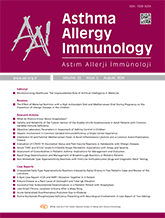


Objective: Recognizing and effectively managing comorbidities in children with asthma is crucial for improving asthma outcomes. This study aimed to identify common comorbidities of asthma during childhood and compare the prevalences of selected comorbidities among children with and without asthma.
Materials and Methods: Children (>5 years old) presenting to our hospital`s pediatric immunology and allergy clinic between October 1, 2023, and October 31, 2024, were retrospectively and cross-sectionally evaluated in this study. The children were categorized into two groups based on the Global Initiative for Asthma guidelines criteria as those diagnosed with asthma and those without asthma. Comorbidities were evaluated according to the parents` reports and electronic hospital records and classified based on the involvement of the respiratory system and/or nonrespiratory manifestations.
Results: A total of 452 patients (58% male) with a median age of 10.5 years (IQR:7.5-10.5) were included in this study, of which 79% exhibited at least one comorbidity. Of the total, 51.7% had asthma, while 48.2% did not. Respiratory comorbidity was more frequently observed in patients with asthma (84.6%) than in those without (72.9%). Comorbidities were more prevalent in patients with asthma with longer asthma duration, sensitization to any aeroallergen, and a higher body mass index. Multivariate logistic regression analysis identified atopic sensitization (OR: 5.5, 95%CI [2.16-14.02], p<0.001) as the sole predictor for the development of comorbidity in patients with asthma.
Conclusion: Our study revealed that a significant proportion (84.6%) of children with asthma exhibited at least one comorbidity, and comorbidities were more frequent in children with asthma than in those without. The frequency of comorbidities increased with a longer asthma duration, the presence of atopic sensitization, and a higher body mass index. Atopic sensitization emerged as a predictor for comorbidity in children with asthma. Therefore, we recommend evaluating all patients with asthma, especially those with atopic sensitization, for other comorbid diseases.